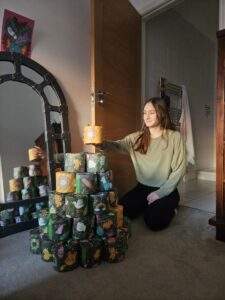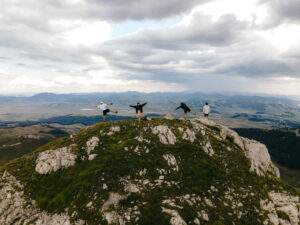I don’t know about you, but I’d never used powdered beauty products before, especially not waterless face wash!
The concept of using dry powder to cleanse one’s pores just doesn’t quite compute…
But I like the idea of reducing transport emissions and I’m all for reducing our use of plastic.
So I set out to do a bit more research into waterless beauty. I wanted to know whether it is actually as green as it claims to be and whether or not it’s any good – even if it’s sustainable, it’s of no use to me unless it works!
Read on to discover an overview of waterless beauty, a powder-powered beauty brand to watch out for, and a step-by-step guide on how to use powder-to-lather products.
Why is water in beauty products?
Water’s main purpose in cosmetics is to act as a solvent. In other words, water dissolves ingredients, to help them do their magic and to improve skin absorption.
When combined with emulsifiers and thicker ingredients such as oils and butters, water can facilitate the formation of emulsions, useful for cream and lotion-based beauty and skincare products.
Is waterless beauty sustainable?
This is such a difficult question to answer because it’s such a complex industry. To work it out, one must examine the entire supply chain, which is often extremely difficult!
Let’s take a very quick look:
Removing the water from beauty products can significantly reduce the amount of packaging required. It even means that plastic-free packaging can be used since the product isn’t as wet or prone to contamination.
However, one must remember that every single beauty product has a water footprint. Even if a product is waterless, it will have needed water in order to grow the ingredients.
And transport uses water too, even if biofuel is used – for example, research estimates that the transportation of shea butter from Ghana to the UK could use approximately 136 litres of water per passenger kilometre. Therefore, it may be best to avoid products with ingredients that have probably been shipped from overseas.
I would also recommend choosing a brand that doesn’t make vague claims like “natural” and “better for the planet”. Instead, search for direct descriptions about how a product is green and look out for credible third party certifications as a guide (e.g. USDA Organic, B Corp, etc.)
According to Ellie Jones, a sociologist who studies greenwashing, if in doubt, shop with smaller, independent brands.
Oh, it’s a minefield out there people! Here are a few more tips to help you navigate greenwashing.
Do powder-to-lather products last longer?
As long as it’s stored properly, the lack of moisture reduces the likelihood that bacterial contamination will occur. This means that waterless products may last longer until they expire.
What’s more, waterless beauty products are undiluted and more concentrated, which means you should definitely get more usage out of them as opposed to conventional products.
You don’t need much powder to create a lather, just make sure you wet your skin (or hair or whichever body part you’re using the product on) first rather than the powder, or you may end up losing quite a lot! Alternatively, sprinkle water on the powder using an alternate hand instead of holding your powdered hands directly under the tap.
Your guide to waterless beauty
The concept of waterless beauty took off in 2015 when a Korean beauty trend focused attention on the potency of skincare ingredients. It wasn’t long before this led to a number of powder-powered products.
As the trend began to spread globally, people quickly realised its potential for reducing the impact that the beauty industry has on the environment.
The benefits of waterless products
- Higher ingredient potency (water is usually still required but can be added in varying concentrations at the time of using the product)
- Less water = smaller and lighter products, which can reduce transport emissions
- Reduction in plastic packaging (although be careful of the substitutes used)
- Products may last longer (in terms of usage and expiration)
- You can take them on the plane as hand luggage!
What about mitigating water scarcity?
Whilst waterless products reduce the amount of water used in their products, as I mentioned in the FAQs above, all beauty products have a water footprint. Since 70% of the world’s water is used to grow crops (some of which are used as ingredients in water-based and waterless products), I’m not sure how much of an impact removing water from the actual product will have on this issue, particularly since water is still required upon application of the product.
Where to try waterless beauty
From shampoo bars to bath bombs, a number of big brands (such as Lush) have been making waterless products for years.
But I’ve always been a fan of trying and supporting new indie brands and I really wanted to give powdered products a go, which is how I found Inclusev.
Inclusev’s beauty products are cruelty-free and vegan, and they’re crafted, produced and packed in-house in the UK. Their products include powder-to-lather handwash, facewash, body wash, and shampoo, which are all made from a blend of plant-based ingredients including aromatherapy oils and some organic ingredients, such as Aloe barbadensis leaf powder.

So far, I’ve been genuinely impressed with Inclusev’s products. I’ve already got a favourite vegan shampoo but I was pleased by how clean my hands, face, and body felt after using Inclusev’s handwash, facewash and body wash.
At the moment, their packaging is made from sugarcane fibre (biopolymer), which is 100% recyclable and can often be picked up kerbside by your local council. Whilst I’m sure this is not perfect, the recent study into ‘home-compostable’ packaging reveals that it may be a better option than some of the other ‘sustainable’ packaging.

How to use waterless beauty facewash
If you decide that you’d like to try waterless beauty, I thought I’d ask my sister Lily to demonstrate how to use the facewash using this step-by-step guide:
1. Wet your hands and face
With clean hands, wet your hands and splash water over your face.

2. Sprinkle powder into your palm
Just a little, you don’t need much!

3. Create a lather
Rub your hands together to create a lather.

4. Massage your face
Gently rub your face in circular motions for 30 seconds.

5. Rinse and dry
Splash your face and wash off all of the lather, then rinse your hands. Pat your face and hands dry with a fresh towel!







